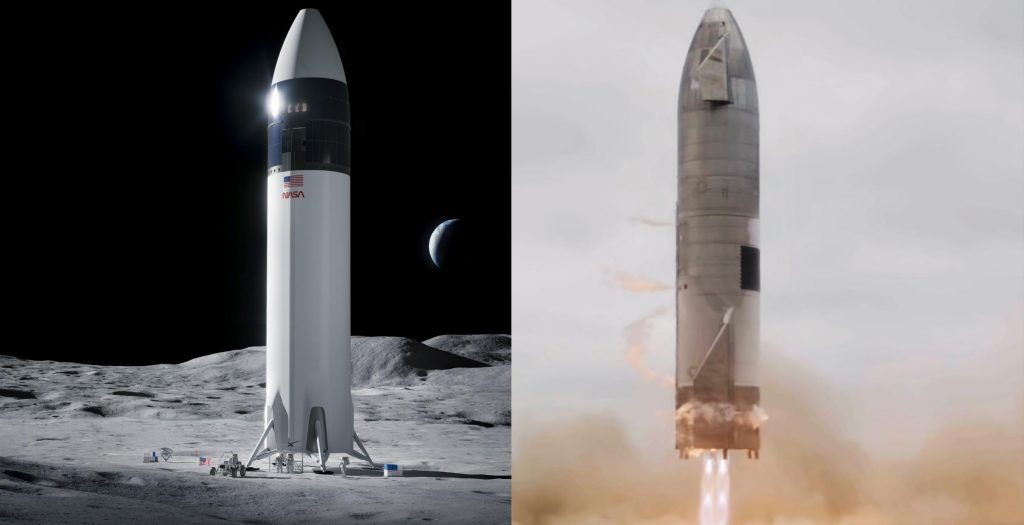Days after Jeff Bezos space startup Blue Origin sued NASA over its decision to solely award SpaceX a contract to turn Starship into a Moon lander, it’s become clear that the space agency will again have to freeze work on the program.
Earlier this week, it was reported that Blue Origin had made good on a veiled threat to sue NASA over disagreements over the space agency’s latest Human Landing System (HLS) procurement decisions. Namely, NASA decided not to proceed with Blue Origin’s National Team Moon lander proposal, which was twice as expensive as SpaceX’s Starship proposal, less technically sound, and promised significantly less cost-sharing.
SpaceX, on the other hand, proposed to turn Starship into a safe, crew-rated, reusable Moon lander for about the same cost as Blue Origin’s proposal price: $6 billion, give or take. However, NASA says that the company offered to pay for more than half of the Starship Moon lander’s development, lowering NASA’s actual cost to just $2.9 billion. Coincidentally or not, $2.9 billion – with some minor concessions on when that funding would be dispersed to the HLS winner – would end up being almost exactly what NASA could afford over the program’s four to five-year lifespan.
As previously discussed on Teslarati, NASA repeatedly and explicitly warned all three HLS Option A competitors (SpaceX, Blue Origin, and Dynetics) that it withheld the ability to award as many or as few contracts as it wanted – including none at all. Ultimately, exactly as it had cautioned, NASA weighed the three proposals it received against its existing budget (a middling $850M of $3.4B requested in FY21) and selected just one – a proposal from SpaceX that was conveniently both the cheapest and most technically sound.
“The fixed-price [Starship] contract will cost NASA $2.9B over four or so years – narrowly within the space agency’s reach if Congress continues to appropriate around $850M annually ($3.4B over four years). The numbers are very simple. As GAO notes [in its protest denial, the Broad Agency Announcement (BAA) tool NASA used for its HLS Option A acquisition also explicitly allowed the agency to select as many or as few proposals as it wants, including none at all. In the lead-up to proposal submission, official NASA documents repeatedly cautioned as much, warning that the agency might not even award one contract depending on funding or the quality of proposals it received.
For Blue Origin’s lawsuit to succeed, the increasingly desperate company will have to convince a federal judge that basic realities and longstanding precedents of federal procurement – not just NASA’s HLS award to SpaceX – are flawed and need to be changed. The odds of success are thus spectacularly low. However, if the presiding judge allows the case to proceed and awards Blue Origin an injunction against NASA, it could force the space agency to cease work on SpaceX’s HLS contract for months and potentially freeze SpaceX’s access to the $300M NASA recently disbursed.”
Teslarati.com — August 16th, 2021
Unfortunately, just as speculated, Blue Origin’s lawsuit appears to have found just enough footing to disrupt the HLS program yet again. Thanks to the first protests of Blue Origin and Dynetics, NASA and SpaceX were forced to stop cooperative work on the Starship Moon lander for more than three months. Now, on August 19th, NASA reportedly “voluntarily paused” work on SpaceX’s HLS Moon lander contract and will continue to do so until November 1st – potentially adding another ~74 days to the 95-day delay Blue Origin’s meddling has already partially caused.
Schedule submitted jointly by all the parties today, and the judge’s order granting the schedule. pic.twitter.com/gyHS4R4j50
— Joey Roulette (@joroulette) August 19, 2021
On its own, the announcement is already fairly bizarre. For unknown reasons, Blue Origin apparently agreed to “an expedited litigation schedule” in return for NASA voluntarily pausing work on SpaceX’s HLS contract. It’s unclear why any plaintiff that believes it has a strong case would allow an artificial limit to be placed on the amount of time available for litigation, but that’s exactly what Blue Origin has agreed to.
Per that “expedited schedule,” NASA’s voluntary work halt will end on November 1st after several scheduled rounds of motions and cross-motions from Blue Origin, SpaceX, and the space agency. It’s unclear when a ruling might be expected but the schedule published seems to imply that it would come sometime before NASA and SpaceX resume work.
It’s now increasingly likely that being forced to spend more than five months without the ability to seriously work or collaborate with SpaceX on its HLS contract will significantly delay NASA’s necessary contributions and thus humanity’s return to the Moon. Thankfully, as was the case with the initial 95-day delay caused by contract protests, no part of Blue Origin’s lawsuit will prevent SpaceX itself from continuing to develop Starship, though it almost certainly hampers the company’s ability to mature its Starship Moon lander design.
In the meantime, while Blue Origin busies itself with a general determination to disrupt NASA’s return to the Moon until it receives a slice of the pie its executives and owner feel entitled to, SpaceX will simply continue a full-court press towards Starship’s orbital launch debut and focus on building, testing, flying, and rebuilding the hardware that will return humanity to the Moon and, just maybe, revolutionize spaceflight as we know it.

